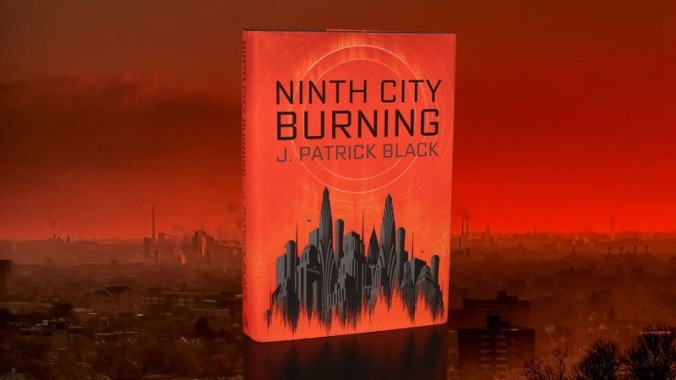
J. Patrick Black adds the manic engineering student Kizabel to his extensive roster of narrating characters about halfway through Ninth City Burning. The addition is jarring not just because she’s another voice in an already crowded narrative, but because the prose about her secret cutting-edge project is punctuated by footnotes to explain all the technical terms she’s introducing along with her references to “Common Era” pop culture like The Clash. While Kizabel tries to work out what’s wrong with her new alien-fighting war mech, her first chapter provides a perfect encapsulation of everything that keeps Black’s ambitious debut novel from succeeding.
Set 500 years after an army from another universe invaded Earth and destroyed most of the planet’s major cities, Ninth City Burning follows seven characters from three societies with very different views on the conflict. Humanity has been able to fight back because a small percent of the population can harness the invader’s primary weapon, a poorly understood force called thelemity. Those who can produce thelemity, dubbed fontani, become near godlike beings that can power entire armies and are only threatened by mystical duels of wills set in anachronistic mindscapes. Humans who directly channel the power are capable of bending the laws of physics to their whims. While the denizens of the planet’s 12 cities use that power to fight off the invaders, the rest of humanity lives in either depressing settlements, where they toil for 16 hours a day to support the war effort and hope not to be drafted to the front, or eke out survival as nomadic tribes.
Black devotes a huge amount of space to detailing how his world works, whether or not it’s plot relevant. There are names for everything from mijmere—a dreamlike place fontani go when they’re using their powers—to the disappearing disappearing blood-like substance, dubbed gwayd, used to conduct power in the animated monsters that the Ninth City’s cavalry units pilot. Delivering both a lexicon and setting is a burden for any genre work, but the problem is that Ninth City Burning’s plot is too thin to be worth the effort of keeping up.
While it’s not billed as YA, the book draws heavily from genre clichés, starting with an excruciating chapter from Jax, an insecure 12-year-old fontani wishing he didn’t have the responsibility of being chosen to defend his whole city from an alien attack. Then there’s Kizabel and the brilliant young officer Vinneas who use math to discover that the aliens are changing their tactics, but are ignored and sidelined by a resentful leader who’d rather keep telling everyone what they want to hear. Of course the young heroes and some sympathetic adults come together to save the day using their ingenuity and passion, but not before some of Earth’s cities are utterly annihilated. But given how everyone who matters was already located in Ninth City, the losses feel utterly meaningless.
Black tries to distinguish the denizens of the cities, settlements, and “Unincorporated Peoples” through linguistics. That mostly translates as the four city-dwelling characters’ chapters teaming with technical information, while the nomads are more matter of fact and prone to referencing the pre-invasion stories they like to keep alive like Gulliver’s Travels and Harry Potter. Most discordant is the character Torro, whose settlement’s slang—like “boyo” and “kiddos”—makes him feel like a Greaser dropped into the plot of Starship Troopers. That quirk would again be much easier to deal with if Torro wasn’t also the book’s most unnecessary character, basically just an add-on to show war is hell but nice people will do well if they stick together. The tone also changes wildly with the language, moving from Naomi and her tribe running from vicious Nworkie warriors—marked by their I ❤ New York tattoos—to Jax’s fanciful training session with his 500-year-old Yoda-quoting mentor.
Black’s mix of fantasy and science fiction and his ideas for solving the problems endemic in other alien-invasion stories are intriguing, but Ninth City Burning’s strengths are drowned by his abundance of jargon, clichés, and geek culture pandering. This is the first in a promised series, so hopefully he’ll learn from his debut’s failings to pen a sequel that can make better use of his world-building.
Purchasing via Amazon helps support The A.V. Club.